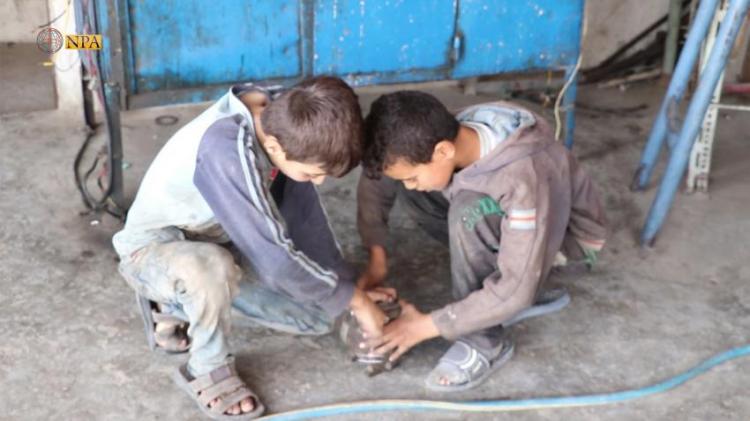Low-paid child labor spread in Hasakah
Dilsoz Youssef / Jindar Abdulqader
Child labor phenomenon is remarkably spreading in the city of Hasakah in northeastern Syria, despite the start of the new school year, because of the deteriorating economic situation and the displacement of many families into the city, which forced them into incompatible jobs with their physical structure.
The spread of this phenomenon comes at a time when many humanitarian organizations and institutions concerned with children’s rights are active within the region.
Worn-out jobs and low wages
Ibrahim al-Asa’ad is a 14-year-old child from al-Aziziyyah neighborhood in the city of Hasakah, he works in the industrial area after leaving school, he said: “I love school but I have to work, my father is a porter and I’m forced to work in order to help him”.
In spite of the nature of his work, which exceeds his physical abilities for a small weekly wage of 1,500 SYP (about $2,5), but he recalls that he is working to support his family financially.
While Abdul Latif Ibrahim, a 16-year-old from Deir ez-Zor, also works in the industrial area after he and his family fled to Hasakah two years ago, escaping the war.
“I work with bodyworks for a daily wage of 1,000 SYP (about $1,5), in order to support my family, my father is unemployed, and our family consists of 10 members, and I’m the eldest son among them”.
Absence of statistics
Along with the organizations, the Autonomous Administration which manages the north and eastern regions of Syria lack projects of finding solutions, albeit partially, to this phenomenon.
Farhan Mirzo, an administrator at the Social Affairs Committee of the Autonomous Administration in Hasakah told North-Press: “They are about to conduct a general statistics regarding the numbers of the children involved in child labor”.
Mirzo said that the statistics would also include children begging at the level of Hasakah governorate, stressing that they will work accordingly “to put an appropriate mechanism to reduce this phenomenon”.
There is no mechanism of work
While this year, schools were opened about 10 days ago, but a specific segment of children are absent from these schools, who are busy in the labor market under difficult circumstances, weighing heavily in order to support their families.
Azad Mahmoud, an administrator at Hassakeh Schools Committee, told North-Press that the Syrian war has had a major impact on children, many schools have been completely destroyed, in addition to the displacement processes due to the war.
He pointed out: “There is a good segment of students, who are old, studying in the early stages after they have been away from school for years, and these factors will all affect the future of children negatively”.
Mahmoud said that they don’t have a specific mechanism to bring the children back from the labor market and from begging into school for the time being, noting that they will work to find solutions for this phenomenon in the near future.
In its latest report regarding children’s education, UNICEF announced that 2,1 million Syrian children are out of schools in Syria, while it estimated the number of school dropouts from Syrian children in neighboring countries where they had taken refuge, of about 700,000.

